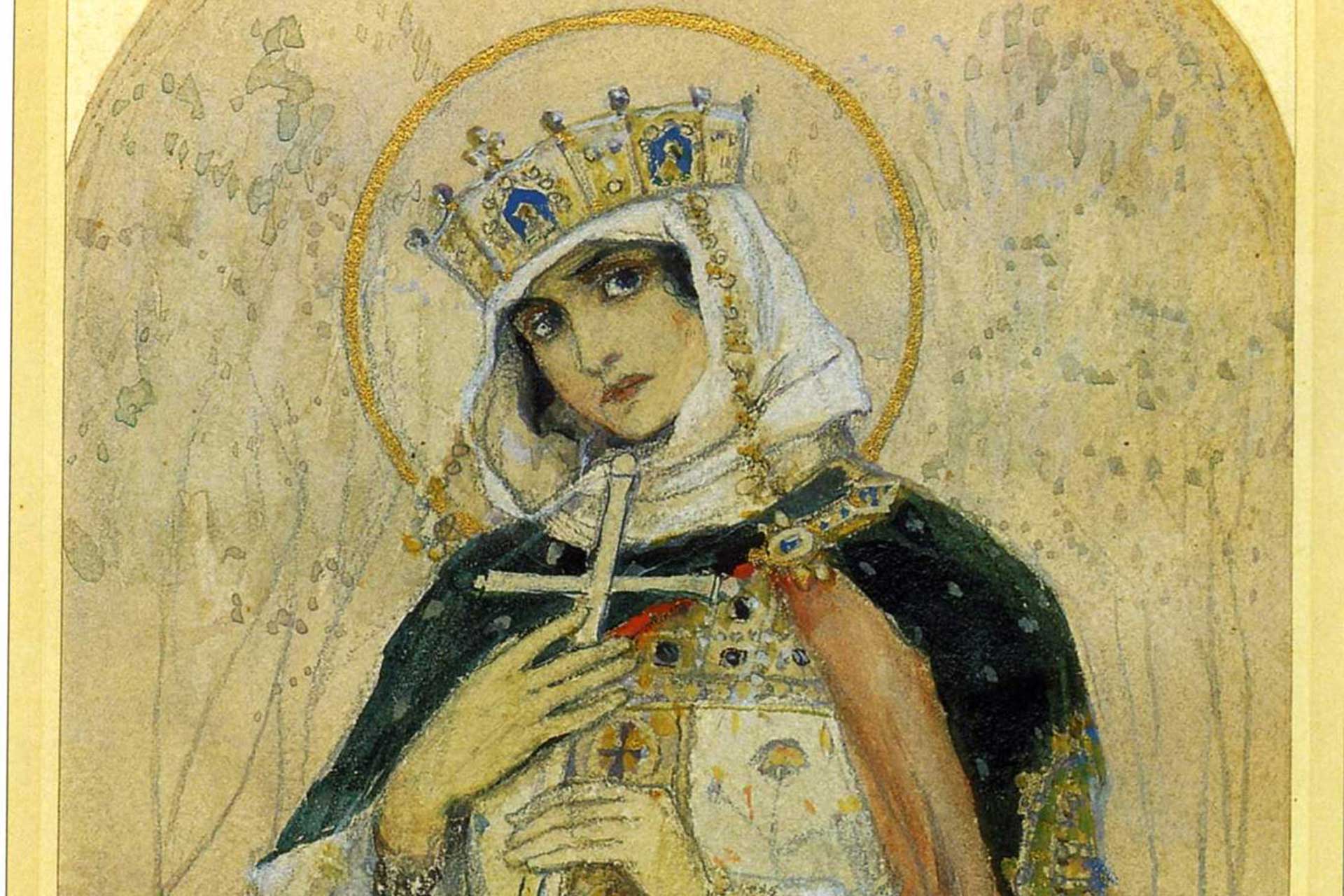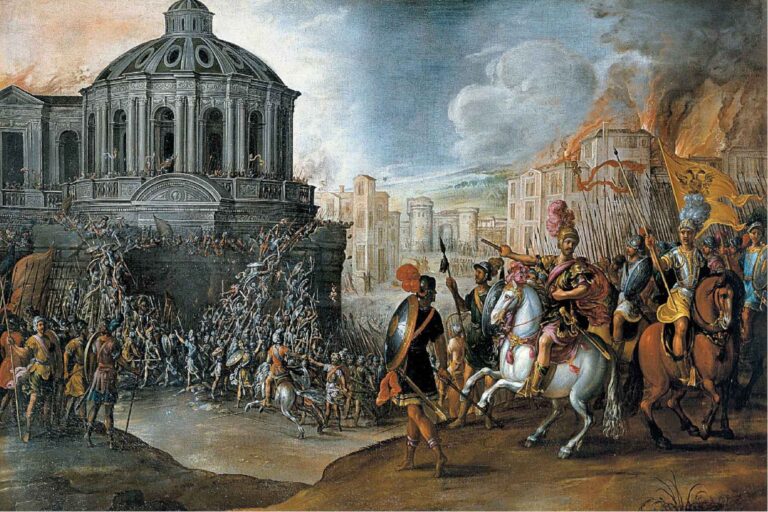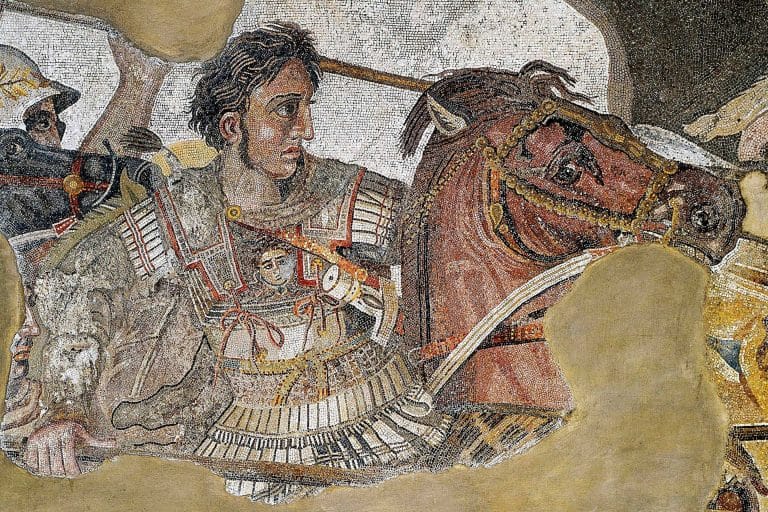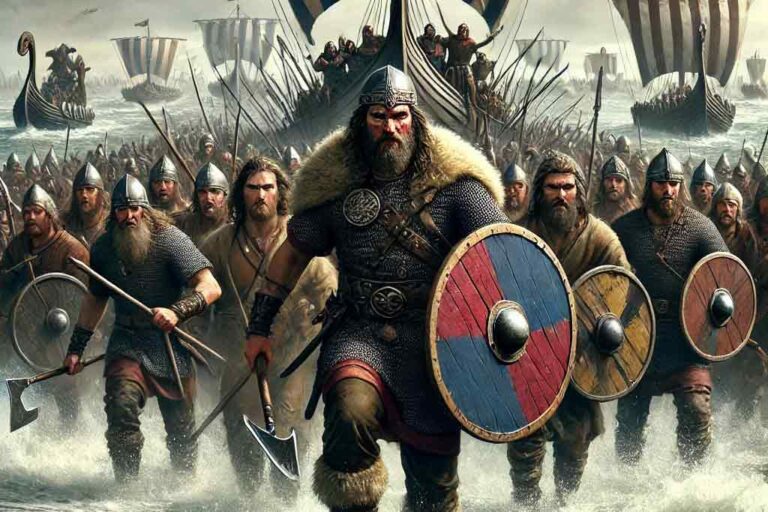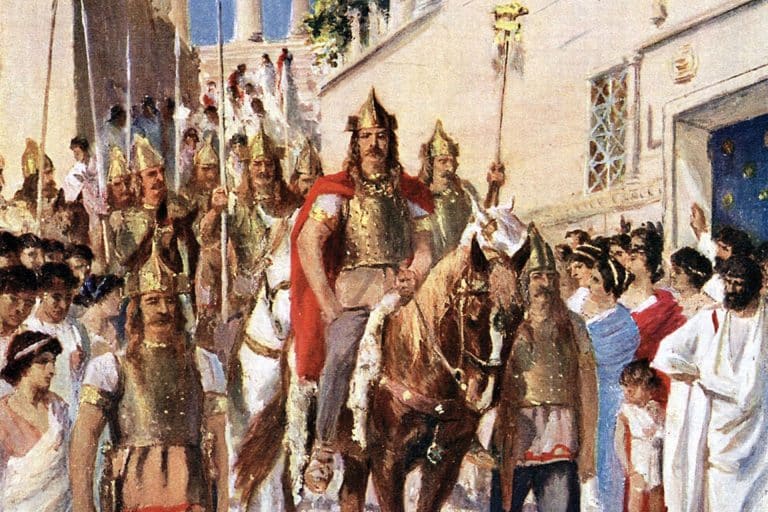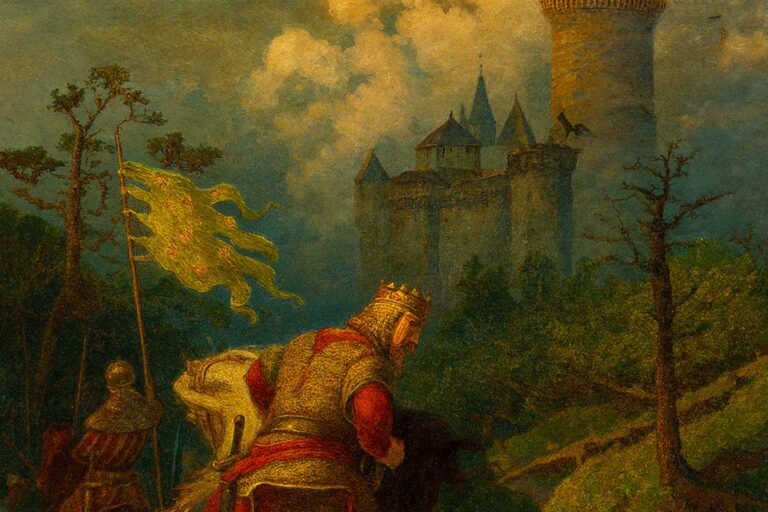The Dual Faces of Olga of Kiev Vengeful Saint and Pious Leader
Olga of Kiev embodies the stark dichotomy between vengeance and righteousness. Her tale weaves through the darkest shades of retribution and the light of holy leadership, presenting a persona that challenges the simplistic categorization of historical figures. Olga’s journey from the depths of vengeful wrath to her ascent as a revered Christian saint encapsulates a transformation that is as bewildering as it is inspiring. This duality marks her legacy with a unique distinction and offers a profound commentary on the complexity of human nature and the potential for change.

Olga of Kiev: From Princess to Widow
Olga of Kiev’s story begins shrouded in the mists of the late 9th or early 10th century, with her birth year speculated to fall between 890 and 925 AD. Her origins are rooted in the Varangian legacy, emerging from the historical tapestry of Pleskov. Her life before marriage remains largely a mystery, marked only by her union to Prince Igor I of Kiev at a tender age, possibly not exceeding fifteen.
Igor, son of Rurik, the progenitor of the Rurik dynasty, ascended to leadership under the tutelage of Oleg, who had firmly established Kievan Rus as a dominant force across the expansive territories of modern-day Russia, Ukraine, and Belarus. Though loosely structured, this federation began to carve out its identity and influence under their rule.
The stage of Olga’s early life was closely intertwined with the Drevlians, a tribe whose fate would become inseparably linked with her own. The Drevlians, erstwhile allies in military endeavors against the Byzantine Empire and tributaries to the Kievan Rus’, ceased their payments following Oleg’s demise, redirecting their tribute to local chieftains.
In an attempt to reassert dominion and secure the tribute by force, Igor ventured into the heart of Drevlian territory in 945. Although his initial demand was met, greed spurred him to seek an additional tribute, a decision that would lead to his violent death. The Byzantine chronicler Leo the Deacon narrates a grim end for Igor, claiming he was brutally torn apart by the Drevlians in a savage act of retribution—a tale that, while possibly embellished, underscores the brutal customs of the time and sets the stage for Olga’s transformative journey from a grieving widow to a formidable ruler and saint.
The Beginning of Olga’s Retribution
Following the brutal murder of her husband Igor by the Drevlians, Olga of Kiev ascended to the throne, taking the reins of Kievan Rus’ as regent for her young son, Sviatoslav. Her rise marked a pivotal moment in the annals of the realm, as she became the first woman to wield such power within the dominion. Her rule was characterized by a blend of wise governance and the initiation of civil reforms.
Yet, beneath the veneer of her administrative acumen lay a simmering quest for vengeance against the Drevlians for their heinous act. Olga’s response to their audacious proposal for her to marry the orchestrator of her husband’s demise would set the stage for a legendary tale of retribution.
The Drevlians, underestimating Olga’s resolve and cunning, dispatched twenty of their envoys to Kiev with a proposal that insulted the memory of the fallen king. They suggested Olga of Kiev wed Prince Mal, the very hand behind Igor’s assassination, presenting an alliance cemented in treachery. Olga’s reply was a masterpiece of deceptive acquiescence. She invited the Drevlian emissaries to return on the morrow, promising them a ceremonial honor in the presence of her subjects. The Drevlians, blinded by their arrogance, walked into a meticulously planned trap.

As dawn broke, the Drevlians were carried aloft in their boat by the people of Kiev, believing they were receiving a regal accolade. Their pride, however, quickly turned to horror as they were lowered not onto the soft cushions of a palanquin but into a deep trench prepared under Olga’s command. The earth closed over them in a premature burial; their lives extinguished in a grim mimicry of the honor they had anticipated.
Olga of Kiev allegedly “inquired whether they found the honor to their taste.” This cold inquiry into their enjoyment of the honor laid bare the depth of her vengeance, marking the first act of retribution that would forever change the legacy of the Drevlian uprising and etch Olga’s name into the annals of history as a ruler of unmatched resolve and ruthlessness.
The Escalation of Olga’s Vengeance
Olga of Kiev’s thirst for retribution was far from quenched with the burial of the Drevlian envoys. Her following stratagem involved a cunning deception that preyed on the Drevlians’ obliviousness to their comrades’ fate. She invited the Drevlian nobles to visit her in Kiev, ostensibly to honor her impending visit to their prince.
The Drevlians, unknowingly stepping into the heart of danger, sent a delegation of their most esteemed men to Kiev. Upon their arrival, Olga offered them hospitality through a bathhouse visit. It was here that her merciless plot unfolded; the doors were sealed, and the bathhouse was set ablaze, leaving none within alive. This ruthless act was a stark demonstration of Olga’s resolve and a grim prelude to her next, even more devastating, act of vengeance.
Not yet satisfied, Olga concocted a plan that was as elaborate as lethal. She beckoned the Drevlians to prepare a funeral feast at the site of her husband’s death under the guise of mourning. As the Drevlians indulged in the copious mead provided, their senses dulled by intoxication, Olga’s trap was sprung. The scene swiftly transformed from one of supposed shared grief to a bloodbath as Olga’s forces slaughtered the inebriated Drevlians by the thousands. This night of treachery further cemented Olga of Kiev’s legacy as a figure of both awe and horror.
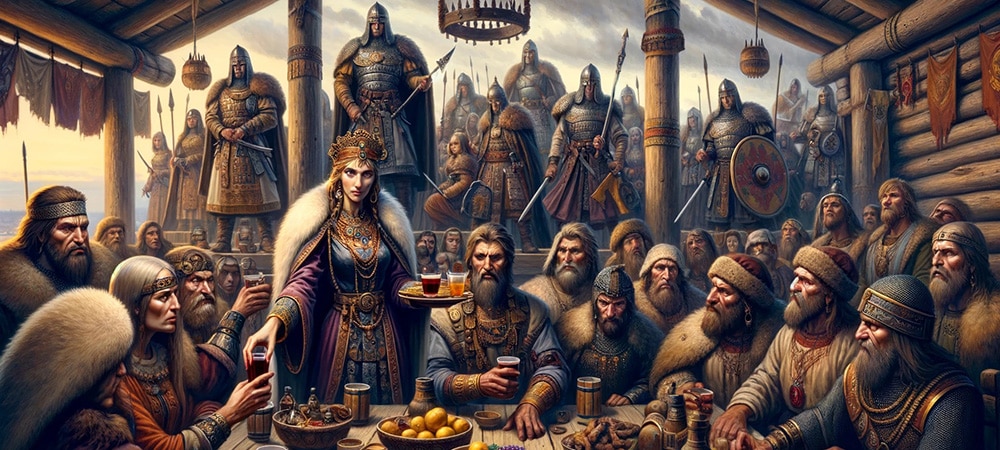
Through these acts of calculated vengeance, Olga not only decimated the Drevlian leadership but also demonstrated a chilling proficiency in warfare and psychological manipulation. Her return to Kiev to muster an army for a final assault on the Drevlian survivors marked the transition from personal revenge to outright military conquest. These episodes in Olga’s rule illustrate the dual aspects of her character: a ruler capable of both enlightened governance and ruthless vengeance, leaving an indelible mark on the history of Kievan Rus’ and the legacy of its vengeful saint.
The Consummation of Vengeance
The saga of Olga of Kiev’s revenge reached its zenith with a cunning stratagem that decimated the Drevlians, sealing her legacy as both a vengeful widow and a tactical genius. After the deceptive peace offering and the subsequent massacre of the Drevlian envoys, Olga marshaled her forces, signaling the dawn of a relentless campaign against the tribe responsible for her husband’s murder.
The initial clashes saw the Drevlians outmatched and outmaneuvered, forcing them back into the stronghold of Iskorosten, the very ground where Igor had met his grisly end. The ensuing siege, lasting a year, seemed futile until Olga unveiled a plan marked by its ingenuity and ruthlessness.

Olga’s message of peace, promising leniency in exchange for tribute, was a masterpiece of deception. Her request for three pigeons and sparrows from each household under the guise of a tribute was met with relief by the besieged Drevlians, unaware of the doom they were bringing upon themselves.
Olga of Kiev ordered her army to attach small pieces of cloth tied with sulfur to each bird. These were set ablaze at dusk, turning the pigeons and sparrows into unwitting arsonists. As they scattered across the city, seeking the safety of their nests, the flames spread uncontrollably from thatch to thatch, igniting a conflagration that consumed the entirety of Iskorosten. The brilliance of Olga’s cruel ingenuity lay not just in the execution of her plan but in its symbolism; the very creatures that symbolized peace and homecoming brought destruction upon their abodes.
The aftermath was a scene of chaos and despair as the Drevlians fled their incinerated city, only to be met by Olga’s merciless soldiers. The survivors, trapped between the inferno and the sword, faced a grim fate. Some were slain outright, their attempts to escape cut short by cold steel. Others were captured, destined for a life of servitude under their conquerors. Olga’s retribution was complete, leaving a stark message to anyone who challenged her rule or harmed her kin. Through a blend of strategic brilliance and ruthless execution, she avenged her husband’s death. She secured her legacy, ensuring that the tale of her vengeance would echo through the ages as a testament to her cunning and resolve.
Pious Leadership: Olga’s Reign and Religious Transformation
After the ashes of revenge settled, Olga of Kiev’s governance heralded a new era for Kievan Rus’. As regent, her reforms in tribute collection marked the first legal overhaul in Eastern Europe, laying foundational stones for state centralization and administrative efficiency.
Her resolve in governance was matched by an unwavering dedication to her people’s welfare, as evidenced by her strategic establishment of trading posts and hunting reserves. These initiatives not only bolstered the state’s economy but also facilitated the cultural and ethnic unity of the Rus’ people. Olga’s rule was a testament to her multifaceted legacy, combining sagacious leadership with a visionary approach to statecraft.

However, the turning point in Olga’s life came with her conversion to Christianity during a visit to Constantinople. This pivotal event was a personal transformation and a strategic move that positioned Kievan Rus’ closer to the Christian world. The Byzantine Emperor’s and Patriarch’s involvement in her baptism underscored the significance of this conversion, marking Olga not only as a devout Christian but also as a bridge between Eastern Orthodox Christianity and the pagan traditions of her people. This blend of piety and pragmatism underscored her role as a leader who navigated her kingdom through cultural and religious transitions.
Olga’s conversion to Christianity and subsequent efforts to spread the faith across Kievan Rus were driven by a deep conviction in the teachings she embraced in Constantinople. Despite the Chronicle’s narratives of political maneuverings, her dedication to Christian values and teachings was genuine and transformative.
By introducing Christianity to her realm, Olga laid the groundwork for the eventual Christianization of Kievan Rus’, a legacy that would outlive her and shape the spiritual direction of the region for centuries. Her role as both a vengeful ruler and a pious leader exemplifies the dual aspects of her legacy, intertwining acts of retribution with a deep-seated commitment to faith and moral governance.
Olga of Kiev: A Saintly Legacy Beyond Vengeance
The death of Olga of Kiev in 969 marked the end of an era and the beginning of a legacy that would profoundly influence the spiritual landscape of Kievan Rus’. Her passing, surrounded by family and subjects after a prolonged siege by the Pechenegs, underscored a life that was as dedicated to her people in death as it had been in life.

Despite her son Sviatoslav’s initial resistance, Olga’s Christian funeral rites were observed, eschewing the pagan traditions of her time in favor of the faith she had embraced. This act not only cemented her place in history as a Christian figure but also signaled a shift in the religious practices of the region, even if her dream of a Christian Kievan Rus’ would only be realized posthumously.
The sainthood of Olga of Kiev, though not immediate, was an acknowledgment of her pivotal role in the Christianization of Kievan Rus’. Her canonization, alongside her grandson Vladimir in 1284 by the Russian Orthodox Church, underlined her status as a venerated figure equal to the apostles.
This title was bestowed upon her for her efforts in spreading Christianity, making her a beacon for converts and widows alike. Her body, found uncorrupted years after her death, was enshrined, reinforcing the miraculous nature of her faith and the impact of her conversion. The destruction of her tomb by Mongolian-Tatar forces could not erase the spiritual foundation she had laid for her people.
Today, Olga’s memory is celebrated across East Slavic-speaking countries, with her feast day observed with reverence and admiration for her courage, foresight, and devoutness. As the patron of widows and converts, Olga of Kiev is a testament to the power of faith and the enduring strength of her convictions. Her story, woven into the fabric of Eastern Christianity, inspires those who seek to navigate the complexities of faith, leadership, and legacy.

